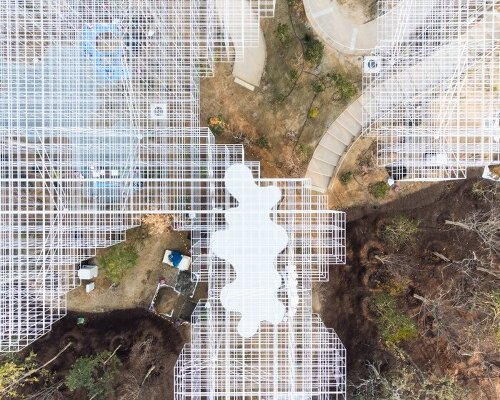william mulvihill reveals ‘better co-being’ under construction
Within the Forest of Tranquility at Expo 2025 Osaka, SANAA’s Better Co-being Pavilion appears as a delicate field of white columns and overlapping roof plates that hover just above the landscape. Designed by the Japanese Pritzker Prize–winning duo Kazuyo Sejima and Ryue Nishizawa, the pavilion is composed of slender steel supports topped by a constellation of thin, translucent canopies, some circular, others irregular, recalling clouds or tree branches.
The columns are positioned in a seemingly organic arrangement, creating soft porous pathways, gathering points, and transitional moments within the wooded clearing. This unenclosed architecture, defined by natural rhythms, porosity, and light, echoes its organic context. New photographs by William Mulvihill document its early stages of assembly, capturing how SANAA’s architectural language of lightness and ambiguity is resolved through precise material detailing and structural calibration.
all images by William Mulvihill unless stated otherwise
sanaa’s expo osaka pavilion appears as a field of white canopies
Curated by art critic and curator Yuko Hasegawa, and produced by Hiroaki Miyata, a professor and lead researcher for the thematic project Resonance of Lives, the pavilion is one of several projects at Expo 2025 Osaka exploring how architecture can facilitate new forms of coexistence. Miyata’s framework centers around the idea that we are entering a global turning point, spanning economics, health, education, human rights, and environmental practice. SANAA conceives this to act like a social interface in this context, a place where people can gather, interact, and imagine alternative models for living together.
This ethos is embedded in the physical language of the project. Better Co-being embraces the idea of ambiguity and openness. The architects have selected materials that are almost diagrammatic in their simplicity — from lightweight steel columns to translucent roof panels — somewhat recalling data networks or cellular structures. Without any harsh boundaries, the pavilion then allows the landscape to almost entirely flow through it. Light filters down through the layered roof elements in constantly shifting patterns, changing with the weather and time of day. Photographed during construction, William Mulvihill’s photo series emphasizes this transitional quality, framing the pavilion from different perspectives as it appears mid-formation with geometries only partly resolved.
SANAA’s Better Co-being Pavilion
on view at Expo 2025 Osaka’s Forest of Tranquility
appearing as a delicate field of white columns and overlapping roof plates that hover just above the landscape
William Mulvihill captures the structure under construction
the organic arrangement creates soft porous pathways, gathering points, and transitional moments
the series captures how SANAA’s language of lightness is resolved through precise material detailing
without any harsh boundaries, the pavilion then allows the landscape to almost entirely flow through it
image © designboom
image © designboom
project info:
name: Better Co-being
architect: SANAA | @sanaa_jimusho
photographer: William Mulvihill | @williamulvihill
location: Osaka, Japan
event: Expo 2025 Osaka | @expo2025japan
dates: April 13th — October 13th, 2025
The post a closer look at the making of SANAA’s ethereal ‘better co-being pavilion’ at expo 2025 osaka appeared first on designboom | architecture & design magazine.

